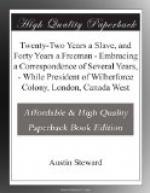I was born in Prince William County, Virginia. At seven years of age, I found myself a slave on the plantation of Capt. William Helm. Our family consisted of my father and mother—whose names were Robert and Susan Steward—a sister, Mary, and myself. As was the usual custom, we lived in a small cabin, built of rough boards, with a floor of earth, and small openings in the sides of the cabin were substituted for windows. The chimney was built of sticks and mud; the door, of rough boards; and the whole was put together in the rudest possible manner. As to the furniture of this rude dwelling, it was procured by the slaves themselves, who were occasionally permitted to earn a little money after their day’s toil was done. I never knew Capt. H. to furnish his slaves with household utensils of any description.
The amount of provision given out on the plantation per week, was invariably one peck of corn or meal for each slave. This allowance was given in meal when it could be obtained; when it could not, they received corn, which they pounded in mortars after they returned from their labor in the field. The slaves on our plantation were provided with very little meat In addition to the peck of corn or meal, they were allowed a little salt and a few herrings. If they wished for more, they were obliged to earn it by over-work. They were permitted to cultivate small gardens, and were thereby enabled to provide themselves with many trifling conveniences. But these gardens were only allowed to some of the more industrious. Capt. Helm allowed his slaves a small quantity of meat during harvest time, but when the harvest was over they were obliged to fall back on the old allowance.
It was usual for men and women to work side by side on our plantation; and in many kinds of work, the women were compelled to do as much as the men. Capt. H. employed an overseer, whose business it was to look after each slave in the field, and see that he performed his task. The overseer always went around with a whip, about nine feet long, made of the toughest kind of cowhide, the but-end of which was loaded with lead, and was about four or five inches in circumference, running to a point at the opposite extremity. This made a dreadful instrument of torture, and, when in the hands of a cruel overseer, it was truly fearful. With it, the skin of an ox or a horse could be cut through. Hence, it was no uncommon thing to see the poor slaves with their backs mangled in a most horrible manner. Our overseer, thus armed with his cowhide, and with a large bull-dog behind him, followed the slaves all day; and, if one of them fell in the rear from any cause, this cruel weapon was plied with terrible force. He would strike the dog one blow and the slave another, in order to keep the former from tearing the delinquent slave in pieces,—such was the ferocity of his canine attendant.




